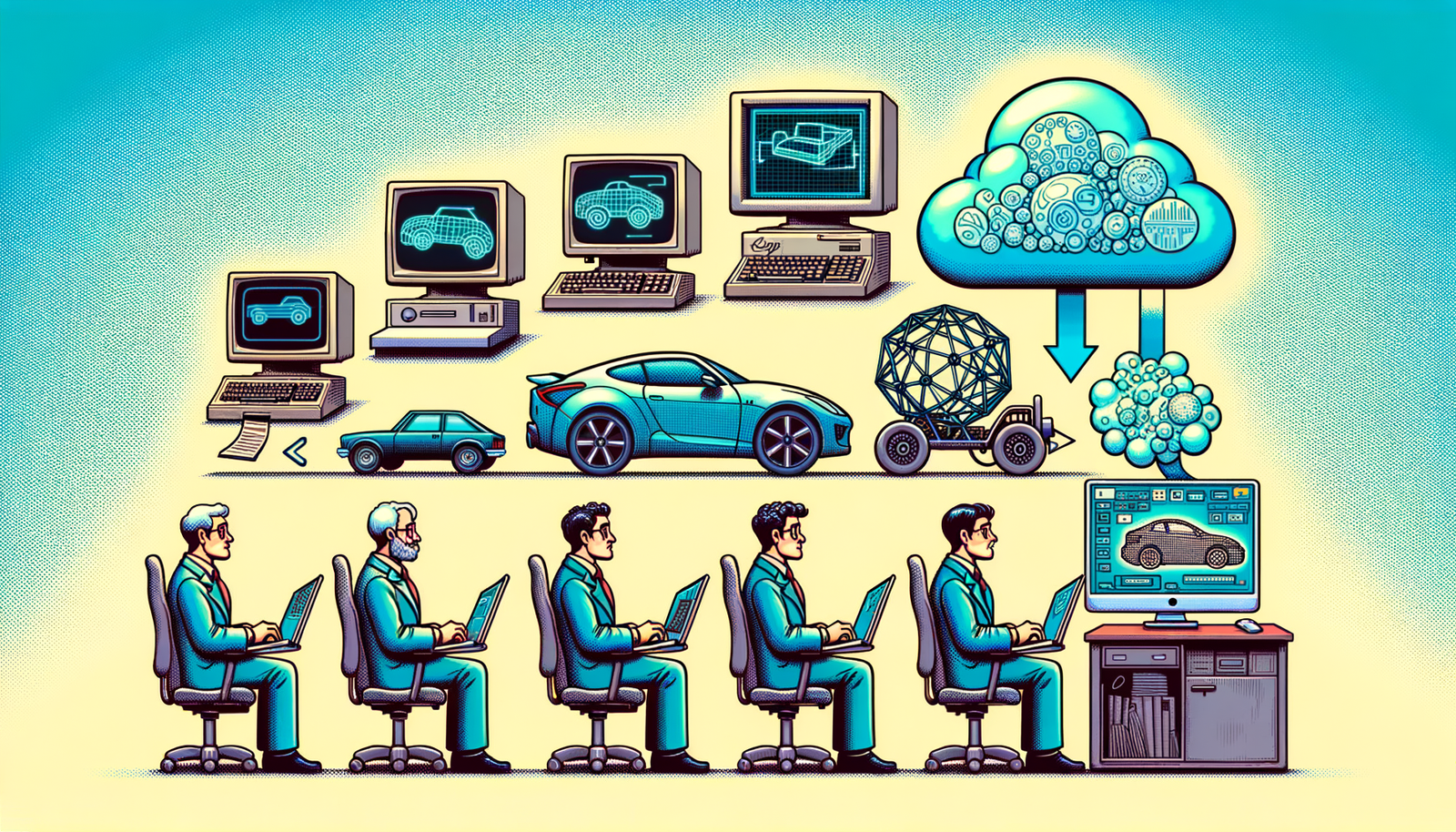Your Cart is Empty
Customer Testimonials
-
"Great customer service. The folks at Novedge were super helpful in navigating a somewhat complicated order including software upgrades and serial numbers in various stages of inactivity. They were friendly and helpful throughout the process.."
Ruben Ruckmark
"Quick & very helpful. We have been using Novedge for years and are very happy with their quick service when we need to make a purchase and excellent support resolving any issues."
Will Woodson
"Scott is the best. He reminds me about subscriptions dates, guides me in the correct direction for updates. He always responds promptly to me. He is literally the reason I continue to work with Novedge and will do so in the future."
Edward Mchugh
"Calvin Lok is “the man”. After my purchase of Sketchup 2021, he called me and provided step-by-step instructions to ease me through difficulties I was having with the setup of my new software."
Mike Borzage
Design Software History: Evolution of Automotive Design Software: From CAD to AI and Cloud Computing
July 01, 2024 4 min read

Blog on Automotive Design Software History
The Development of Design Software for the Automotive Industry
Introduction to Automotive Design Software
Overview of Automotive Design Software
Automotive design software plays a crucial role in the development and production of vehicles. These software solutions enable engineers and designers to create detailed models, perform simulations, and collaborate across various stages of the vehicle development process. The transition from manual drafting to sophisticated software solutions has revolutionized the automotive industry, allowing for greater precision, efficiency, and innovation.
Historical Context
The automotive industry underwent a significant transformation with the advent of computer-aided design (CAD) software. Before the integration of CAD, vehicle design was a labor-intensive process that relied heavily on manual drafting and physical prototypes. Early challenges included the limitations of computing power and the need to develop new methodologies for digital design. However, as technology advanced, so did the capabilities of design software, leading to more efficient and accurate design processes.

Key Milestones in Automotive Design Software
Early Innovations
The introduction of CAD systems in the automotive industry marked a pivotal moment in vehicle design. Companies like General Motors and Ford were among the pioneers in adopting CAD technology. Key figures such as Patrick J. Hanratty, often referred to as the "father of CAD," played a significant role in the development of early CAD systems. Hanratty's contributions laid the groundwork for subsequent advancements in design software.
Transition to 3D Modeling
The evolution from 2D drafting to 3D modeling represented another major milestone in automotive design software. This transition allowed designers to create more detailed and accurate representations of vehicles. Software such as CATIA, developed by Dassault Systèmes, and Pro/ENGINEER, created by PTC, were instrumental in this shift. These tools enabled designers to visualize and manipulate complex geometries, leading to improved design quality and innovation.
Development of Parametric and Solid Modeling
The introduction of parametric design with software like SolidWorks revolutionized the way automotive designers approached modeling. Parametric modeling allows for the creation of models that can be easily modified by changing specific parameters, making the design process more flexible and efficient. Solid modeling, which represents the volume of the object rather than just its surface, provided additional advantages in terms of accuracy and functionality in automotive design.
Major Players and Technologies
Leading Companies and Software
Several key companies have been at the forefront of automotive design software innovation. Dassault Systèmes, with its flagship product CATIA, has been a leader in providing comprehensive CAD solutions. Siemens offers NX, another powerful design tool widely used in the industry. Autodesk, known for AutoCAD and Fusion 360, has also made significant contributions. PTC's Pro/ENGINEER, now known as Creo, has played a crucial role in advancing parametric modeling technologies.
Technological Advancements
The integration of Finite Element Analysis (FEA) and Computational Fluid Dynamics (CFD) into design software has enabled more accurate performance testing and optimization. These technologies allow engineers to simulate and analyze the behavior of vehicle components under various conditions, leading to better-informed design decisions. The role of software in virtual prototyping and simulation has also been significant, reducing the need for physical prototypes and accelerating the development process.
Innovations in User Interfaces and Usability
The evolution of graphical user interfaces (GUIs) has greatly enhanced the usability of design software. Modern GUIs are designed to be intuitive and user-friendly, allowing designers to focus on creativity and problem-solving rather than learning complex software commands. Intuitive design tools and user-centric features have made it easier for engineers and designers to collaborate and innovate.
Current Trends and Future Directions
Integration with Additive Manufacturing
The impact of 3D printing on automotive design and prototyping has been profound. Additive manufacturing allows for the rapid creation of prototypes and complex components, enabling more iterative and experimental design processes. This technology has opened new possibilities for customization and lightweighting, which are critical in the automotive industry.
Artificial Intelligence and Machine Learning
The use of Artificial Intelligence (AI) and Machine Learning (ML) in automotive design is an emerging trend with significant potential. AI can optimize design processes by automating repetitive tasks and providing predictive insights. Machine learning algorithms can analyze vast amounts of data to identify patterns and suggest improvements in design and manufacturing. These technologies are poised to revolutionize the way vehicles are designed and produced.
Cloud Computing and Collaborative Design
Cloud-based design software, such as Onshape and Fusion 360, offers several advantages, including enhanced collaboration and accessibility. These platforms allow global design teams to work together in real time, regardless of their physical location. The collaborative features of cloud-based software have transformed the way automotive design projects are managed and executed.
Sustainability and Eco-friendly Design
Modern design software plays a critical role in developing energy-efficient and environmentally-friendly vehicles. By enabling detailed analysis and optimization of vehicle components, these tools help designers identify opportunities for reducing emissions and improving fuel efficiency. Examples of sustainable design practices include the use of lightweight materials and the integration of renewable energy sources, made possible by advanced design software.
Conclusion
Summary of Key Developments
The history of automotive design software is marked by significant milestones, from the introduction of CAD systems to the development of parametric and solid modeling. Leading companies like Dassault Systèmes, Siemens, Autodesk, and PTC have played crucial roles in driving innovation. Technological advancements in areas such as FEA, CFD, and virtual prototyping have further enhanced the capabilities of design software.
Ongoing Challenges and Opportunities
While the automotive design software industry has made remarkable progress, it continues to face challenges, including the need for continuous improvement in usability and integration with emerging technologies. However, these challenges also present opportunities for further innovation and growth. The potential for AI, machine learning, and cloud computing to revolutionize automotive design is immense.
The Future of Automotive Design Software
Looking ahead, the future of automotive design software is likely to be shaped by ongoing advancements in technology and the evolving needs of the industry. Continuous improvement and adaptation will be essential to meet the demands of new materials, manufacturing processes, and sustainability goals. As the automotive industry continues to innovate, design software will remain a critical enabler of progress and transformation.
Also in Design News

Cinema 4D Tip: Lock Framing Early with Cinema 4D Safe Frames and Aspect Overlays
October 30, 2025 2 min read
Read More
ZBrush Tip: Conservative Projection Workflow for Artifact-Free Detail Transfer
October 30, 2025 2 min read
Read More
V-Ray Tip: Bake Static GI into Lightmaps for Real-Time Engines
October 30, 2025 2 min read
Read MoreSubscribe
Sign up to get the latest on sales, new releases and more …


